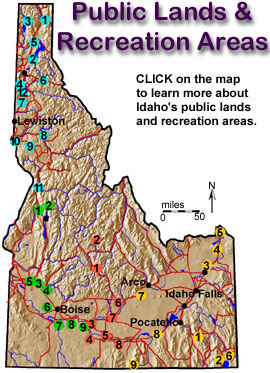The Idaho Department of
Parks and Recreation has historically utilized its enabling legislation (Idaho
Code 67-4219) as its mission statement: "It is the intent of the legislature
that the department of parks and recreation shall formulate and put into execution
a long range, comprehensive plan and program for the acquisition, planning,
protection, operation, maintenance, development and wise use of areas of scenic
beauty, recreational utility, historic, archaeological or scientific interest,
to the end that the health, happiness, recreational opportunities and wholesome
enjoyment of the life of the people may be further encouraged."
Prior to the authorization
of the Idaho Department of Parks and Recreation, there existed in the state
areas designated "scenic and recreational," usually parks and campgrounds.
Since 1907 these areas had been administered by the State Land Board. In 1947,
state parks were transferred to the Highway Department, and responsibility grew
with the addition of a number of roadside areas, where motorists on the freeway
might pull off for a night's rest. In 1949 control of the parks system was transferred
to the State Land Board. A Parks Division was created within the Land Board
in 1953. John W. Emmert, a retired former superintendent of Glacier National
Park, took charge of the Idaho program in April 1958. This form of administration
continued until 1959 when Emmert was replaced with three regional directors.
Since 1965, the Department has been governed by a six-person bipartisan board,
each member representing a different geographic area of the state.
Since it's inception the
State Parks system has grown to include over 25 park and recreation areas. It
is of interest to note that despite the vast wildernesses and high percentage
of federal lands in Idaho, the state does not have a single national park
within its boundaries. The National Park Service does however administer several
national monuments and reserves in Idaho.
On August 25, 1916, President
Woodrow Wilson signed the act creating the National Park Service, a new federal
bureau in the Department of the Interior responsible for protecting the 40 national
parks and monuments then in existence and those yet to be established.
This "Organic Act"
of August 25, 1916, states that "the Service thus established shall promote
and regulate the use of Federal areas known as national parks, monuments and
reservations . . . by such means and measures as conform to the fundamental
purpose of the said parks, monuments and reservations, which purpose is to conserve
the scenery and the natural and historic objects and the wild life therein and
to provide for the enjoyment of the same in such manner and by such means as
will leave them unimpaired for the enjoyment of future generations."
The National Park System
of the United States comprises 378 areas covering more than 83 million acres
in 49 States, the District of Columbia, American Samoa, Guam, Puerto Rico, Saipan,
and the Virgin Islands. These areas are of such national significance as to
justify special recognition and protection in accordance with various acts of
Congress.
By Act of March 1, 1872,
Congress established Yellowstone National Park in the Territories of Montana
and Wyoming "as a public park or pleasuring ground for the benefit and
enjoyment of the people" and placed it "under exclusive control of
the Secretary of the Interior." The founding of Yellowstone National Park
began a worldwide national park movement. Today more than 100 nations contain
some 1,200 national parks or equivalent preserves.
In the years following
the establishment of Yellowstone, the United States authorized additional national
parks and monuments, most of them carved from the federal lands of the West.
These, also, were administered by the Department of the Interior, while other
monuments and natural and historical areas were administered as separate units
by the War Department and the Forest Service of the Department of Agriculture.
No single agency provided unified management of the varied federal parklands.
An Executive Order in
1933 transferred 63 national monuments and military sites from the Forest Service
and the War Department to the National Park Service. This action was a major
step in the development of today's truly national system of parks - a system
that includes areas of historical as well as scenic and scientific importance.
Congress declared in the
General Authorities Act of 1970 "that the National Park System, which began
with the establishment of Yellowstone National Park in 1872, has since grown
to include superlative natural, historic, and recreation areas in every region
... and that it is the purpose of this Act to include all such areas in the
System...."
Additions to the National
Park System are now generally made through acts of Congress, and national parks
can be created only through such acts. But the President has authority, under
the Antiquities Act of 1906, to proclaim national monuments on lands already under
federal jurisdiction. The Secretary of the Interior is usually asked by Congress
for recommendations on proposed additions to the System. The Secretary is counseled
by the National Park System Advisory Board, composed of private citizens, which
advises on possible additions to the System and policies for its management.

![]() = Panhandle
= Panhandle![]() = South West
= South West![]() = South-Central
= South-Central ![]() = East
= East